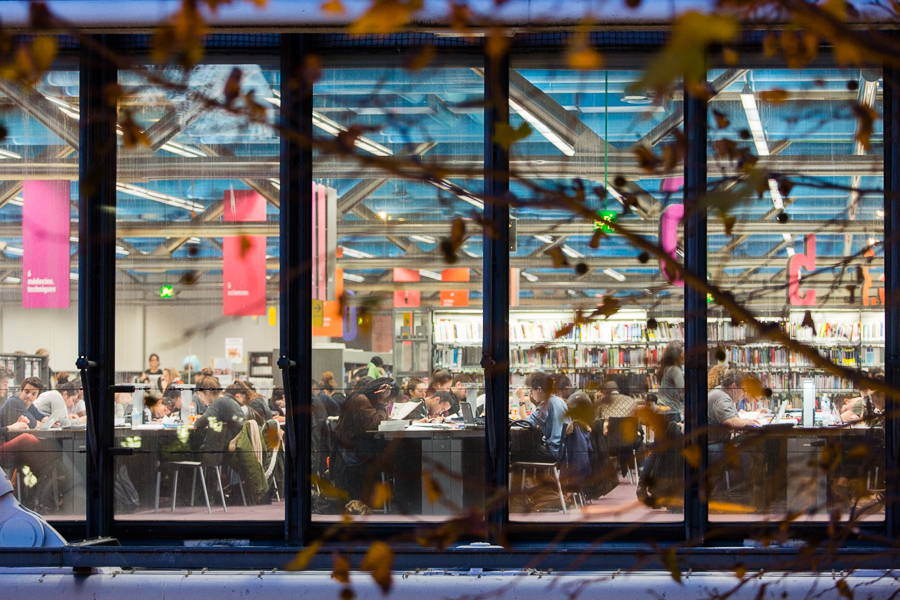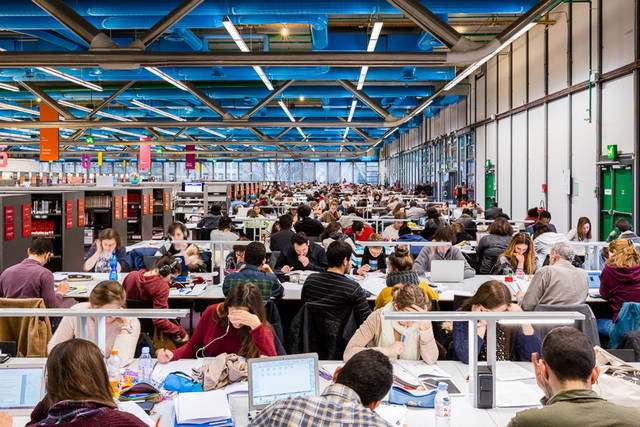The Bpi establishment project

Lire le monde, an establishment project defined in 2010, orientated towards the publics and content
The structure expansion project Lire le monde that Patrick Bazin (director of the Bpi from 2010 to 2013, previously director of the Lyon municipal libraries) submitted to the Ministry of Culture and Communication at the end of 2010 noted the weaknesses of the Bpi, and in particular: visitor numbers that do not represent the population due to frequent saturation; weakening of its function of public reading laboratory in France.
It also pointed out its advantages: its location in Paris and presence in the Centre Pompidou; its breadth of opening; its centres of excellence, well identified and active within professional networks; its finely-tuned management. This project planned to implement four action programmes aiming to vary the audience and uses:
- reorganising work according to a new organisation chart centred on promoting a varied content offering;
- developing cultural action and appreciation assistance around documentary groupings organised into departments;
- establishing an editorial line for content direction through a webmagazine – this programme illustrating the wish of the Bpi to embody the innovative concept of “the library as media”;
- partially reorganising the spaces, the cornerstone of this change in paradigm, allowing appreciation assistance and innovation to be widely included in the library’s operation
The first action programme, the new organisation, has been carried out. Significant progress has been made on the two subsequent programmes; at this stage the fourth programme is still under consideration. The first action programme, the new organisation, has been carried out. Significant progress has been made on the two subsequent programmes; at this stage the fourth programme is still under consideration.
The new organisation, the functional and transversal modes of which were defined in 2011, was implemented between the end of 2011 and the start of 2012 by a huge movement of redeployment which involved all members of staff. The new organisational chart in place since 1 March 2012 is notably based on four documentary and cultural departments, the code names of which express the originality of the Bpi project as much through expression as renewed connection of the library to the world surrounding it.
The second action programme, developing cultural action and appreciation guidance around content, has already been able to be started thanks to this new organisation. It is based on implementing several appreciation actions in the library (workshops, conferences, etc.) as well as reinforced collaboration with the Centre Pompidou, particularly for preparing the three exhibitions (Art Spiegelman – March to May 2012 –; Claude Simon – October 2013 to January 2014; Duras Song– October 2014 to January 2015). Carrying them out shows that an exhibition constitutes an excellent hook to enrich and promote the documentary offer of a library through various forms of cultural appreciation guidance and attract a new audience.
The third action programme, the creation of a webmagazine, Balises, benefitted from project ownership support in 2012 to draw up specifications, resulting in the launch of a call for tender at the start of 2013 and being carried out in 2014. In parallel, the Lire le Monde department boosted content production, thanks to transversal coordination conducted in the spirit of an editorial conference.
The fourth action programme, partially reorganising the spaces, has already benefited from an initial investment budget of €1.55 M, transferred by the Ministry of Culture and Communication at the end of 2011 and intended for financing studies and project management. In April 2012, the Bpi signed a project management agreement with the Opérateur du patrimoine et des projets immobiliers de la Culture (OPPIC) (Heritage and Cultural Buildings Operator), bringing together the MCC and the Centre Pompidou, which allowed it to sketch out the lines of programming for the space, with a first projected layout diagram presented in 2012.
In a letter to the Bpi director dated 3 December 2012, the Minister of Culture and Communication asked him to amend the structure expansion project along the following lines:
- by integrating the cultural priorities the minister had set for the ministry, particularly in terms of artistic and cultural education and new generations;
- by strengthening the library’s sectors of excellence (disability, independent learning, documentary film, digital);
- by maintaining the reception capacity of visitors using the library for study purposes (particularly university and upper secondary schools), that is by maintaining the same number of work spaces compared to those already in place;
- by leading, in close collaboration with the Centre Pompidou, a search to optimise or gain surface areas, with a view of redefining the spaces favouring multi uses, associated with going back to a common entrance;
- by insisting on the Bpi’s ability to be innovative and exemplary in a perspective of national cooperation;
- by ensuring consultation with staff, allowing them to be included in the change process upstream.

Propositions considered extensively jointly in 2013
Before Patrick Bazin retired, in October 2013 he filed a structure expansion project at the Ministry of Culture and Communication along with a Bpi renovation section. This project was drawn up with the Bpi teams and meets strategic lines which must guide the library in the coming years, by adapting the services and premises to new uses and interpretations and access to information and knowledge.
It is a question of diversifying the spaces while conserving the reading places and renovating the library around structuring themes which are: artistic and cultural appreciation guidance; access to lifelong learning; development of press news and contemporary publishing; reinforcing the place of documentary film, by creating a resources centre; establishing an editorial line, by leaning on a new ecosystem of websites integrating a webmagazine (opened at the end of 2014); digital, through access to numerous online resources corresponding to the public’s needs and monitoring new uses of interpretation; creating new spaces enabling artistic and cultural education and taking an interest in media that promote the relationship between images and writing.
Cooperation with French reading libraries join these structuring themes, in order to share information and good practices, to foster exchanging experiences and collaborating on innovative projects.
